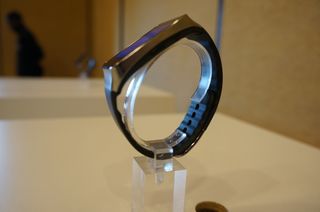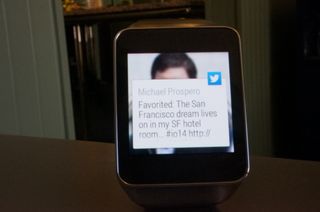Gear Live: Hands On with Android Wear

Back in the spring, Google announced Android Wear, a version of its mobile operating system specifically designed to run on wearable devices. Though Google is quick to clarify that Android Wear is not exclusive to watches and will power a variety of wearable devices in good time, the first push is watches and they're the only Android Wear devices around right now (Google Glass runs on Android but doesn't get Android Wear notifications just yet).
Google announced the launch of two Android Wear smartwatches this week, and the company gave out demo units to developers and attendees at the conference. The G Watch is from LG, and the other is manufactured by Samsung. This isn't Samsung's first smartwatch, but it looks very similar to the company's Galaxy Gear line, which doesn't run on Android. Under the hood, the G Watch and the Gear Live pack the same amount of RAM, the same amount of storage, Bluetooth 4.0, and a 1.2 GHz processor (we know the LG has a Snapdragon 400, but Samsung hasn't specified what chip is powering the Gear Live). Really, the principal differences between these two watches is battery life, the display, and the fact that the Gear Live has a heart-rate monitor while the G Watch does not (LG said they didn't have time to put one in). The screen on the Gear Live is a 1.63-inch Super AMOLED and the display on the G Watch is a 1.65-inch IPS. The battery in the Gear is 300 mAh, but LG has crammed a 400 mAh battery into its G Watch.

There may be some key differences when it comes to build, but the spec sheet doesn't matter all that much. This experience is largely about the software, which is one of the reasons Samsung's Gear line has received such a lukewarm reception. When the Gear first broke cover, a lot of people lamented the fact that it only worked with Samsung devices. When the second version came out, people were stunned that Samsung decided to ditch Android. Samsung switched to Tizen with the Gear 2, and the Gear Fit band runs neither Tizen nor Android. Instead, Samsung chose an RTOS to prolong battery life. All of these decisions might make sense for Samsung, but they don't do much for the user. With Android wear, you don't have that added agenda from the hardware manufacturer. The two Android Wear devices launched this week were designed in conjunction with Google and aim to deliver the Google experience in its purest form, just like the Nexus line of smartphones.
Setup and Apps, Apps, Apps
We took the Galaxy Gear Live out for a spin on day two of Google I/O to see what all the fuss was about. The setup wasn't all that easy, but we were told our experience was not representative of the experience users will have when they boot up on July 7. For starters, anyone outside the United States had to locate a Google rep and have them sideload the Android Wear companion app onto their smartphone. The app isn't available outside the USA yet, and Google apparently figured it was easier to have a Googler sideload the APK for every non-US resident attending I/O than make it available internationally.
Once we'd gotten set up, a Google rep sideloaded roughly 20 Android Wear applications onto our Nexus 5 to help get us going with the Gear Live, including Duolingo, American Airlines, Delta, Eat, Eikon, Glympse, Lyft, and Level. These are all Wear-compatible applications that allow you to do more with your watch than receive notifications from your phone on your wrist. The Duolingo application lets you practice words on your wrist and (unlike the smartphone version) you don't have to talk into the watch to practice. It's more of a quick study session. PayPal Wear (pictured below) lets you shop, make payments, view nearby offers, check your PayPal balance, and view transaction history. Lyft allows you to request a ride using your watch. Really, the app ecosystem is the most exciting aspect of this new platform. Similar to how the launch of Apple's App Store and the Google Play Store propelled the smartphone to new heights, developers will play a key role in ensuring the success of the smartwatch. As the number of Wear-compatible apps grows, so too will the functionality of the device and the overall appeal of owning one of these things.



Customizing the watchface is as simple as changing the wallpaper on your phone (tap and hold to bring up the options), and the setting menu is easily accessed by tapping the top right corner to bring up the 'OK Google' voice recognition app and then swiping up. From here you can adjust the brightness, switch off the always-on screen, and reset the device among other things. There's also access to a number of other features that can be activated by voice, like reminders, alarms, and emails and texts. If you don't feel like saying, "Okay Google, remind me to ... " or "Okay Google, set an alarm for ..." you can launch those features here instead. You still have to use voice to record the memo, but the option to specifically select the task is there.
No Apps, No Problem
Of course, while there are some applications available now, it's going to take a while for developers to populate the Android Wear app catalog. Many of the sessions at Google I/O focused on developing wearables; they were well attended, so the future is bright. But what about the present? The device has to be able to stand on its own, without any outside help from app developers, for the time being.
Stay On the Cutting Edge: Get the Tom's Hardware Newsletter
Join the experts who read Tom's Hardware for the inside track on enthusiast PC tech news — and have for over 25 years. We'll send breaking news and in-depth reviews of CPUs, GPUs, AI, maker hardware and more straight to your inbox.

Yesterday, we used the Gear Live with no Android Wear-specific applications at all, just to see what the vanilla experience would be like for anyone using the device out of the box. To start with, the screen is always on by default and displays the time when you're not actually interacting with the watch. When you lift your hand to check the time, the display lights up and any notifications you have show up under the customizable watch face. We received notifications from Twitter, BlackBerry Messenger, WhatsApp, Hangouts, Groupon, and Gmail with no set up at all. Aside from notifications, the watch also regularly updated us on stocks (AMD and Nvidia), weather (both at home in Toronto and here in San Francisco), and nearby locations using data pulled from Google Now. Anyone with an Android phone will recognize these cards, as they're the same ones that pop up on your phone from time to time as well. If we're honest, they feel more at home on the watch than on our Nexus 5.
The navigation experience is good but it takes some getting used to. Swipe up to scroll through notifications, to the right to dismiss a notification, and down to check battery or turn off the subtle vibrate function that alerts you to a new update. It's not perfect. One of the things everyone we talked to complained about was that once you dismiss a notification, you can't get it back. It's not a major deal, and everyone understood that their messages weren't gone, but an accidental dismissal means you have to go the extra mile and take out your phone.
No Phone and No Friends
Last night, we took the watch out on the town to see how it would affect our social interactions. We'd already nearly killed ourselves crossing the street while dictating a message (don't try that one at home), but how distracting would the device be while socializing? The conclusion we came to was that we focused more on the people we were with because we weren't taking our phones out all the time, but we still kind of looked like jerks.


We didn't spend the whole night thinking "What was that buzz? I wonder if it's important. Maybe I should go to the bathroom so I can check. Maybe they won't mind if I check really quickly right now." Instead, a quick glance down told us it was nothing to worry about. By the end of the night, our connected Nexus 5 was overwhelmed with unchecked notifications that we had seen on the watch but not deemed important enough to address right away. It was kind of satisfying seeing all those text messages and emails that we hadn't let get in the way of our night. However, eliminating the need to take our phone out 18 times over the course of the evening meant we looked at the watch constantly. Within our own group of Google I/O attendees, that wasn't such a big deal. Fifty percent of us were wearing the watches, so we all knew what was going on. Outside of our little bubble of tech understanding was a different story. We came across as impatient, as though we had somewhere to be and the person we were talking to was making us even more late, and we couldn't wait to wrap that conversation up and be on our way. So, less of a distraction overall, but we still felt as though we were being socially insensitive, alienating the people we were with by trying to be less involved with our phones.
Want versus Need
Over all, we love this device. We definitely don't need it, but we have fallen in love with it over the last 24 hours. That's the challenge manufacturers will face when they try to market this to the general public. How can you convince someone to buy something they don't need and kind of have to use to see the benefit? Because Google isn't allowing custom UIs, the experience will remain very consistent across the different models, so selling smartwatches is going to be about price and design more than anything else. In our opinion, at $229, the G Watch is a little bit too expensive. People buying a phone on contract will pay the same for the smartphone itself, so the companion device should really be priced a little more like an accessory as opposed to a standalone device. Samsung's watch is $199, which is a little bit more appealing simply because it comes in just under that $200 mark. If it were to drop down to $150, it would probably sell really, really well. Asus apparently has plans for its own smartwatch that will be even cheaper.
Follow Jane McEntegart @JaneMcEntegart. Follow us @tomshardware, on Facebook and on Google+.
Most Popular




